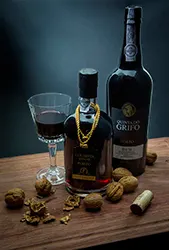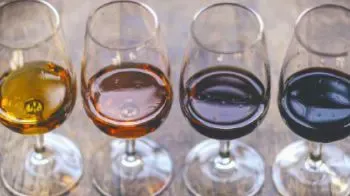The Art of Port Wine

Port Wine is a fortified wine produced in the Porto and Douro Wine Region. It is distinguished from other types of wine due to several characteristics, such as the intensity of aroma, the intensity of flavor and the high alcohol content it contains (usually between 19 and 22% vol.).
Unlike other types of wine, the Port wine making process includes stopping the wort fermentation by adding wine spirit.
The History of Port Wine
Port wine is produced exclusively in the Porto and Douro region, in the North of Portugal. Although its production is made 100km from the city of Porto, it owes its name to the city of Porto since it was from there that it was exported to the rest of the world.

Image: IVDP
Since the 17th century, relations between Portugal and the United Kingdom have been very important in the history of this wine. English Port wine producers argue that the discovery of adding Brandy to wine, to prevent it from souring, was made by British merchants. But, in fact, this method has been used by the Portuguese since the Discoveries, with the purpose that the wine would not lose its properties on long journeys. However, we cannot remove the UK from the equation since they made the internationalization of Port wine possible.
Every year, on September 10, Port Wine Day is celebrated and, to celebrate this day, the Instituto dos Vinhos do Douro e do Porto usually organizes a small "festival" with wine tasting, a sunset party and even a boat race!
Different types of Port Wine
VINTAGE PORT

Considered the king of Port wines, it is a wine made in a special year. Usually it is bottled between the 2nd and 3rd year after harvest. As this wine ages in the bottle, it becomes smooth and elegant and loses its initial astringency, acquiring a balanced, complex and distinct bouquet.
Not every year is a “vintage” year, it is only declared vintage if the Port wine producer considers that the harvest was exceptional and that the wines have the potential for aging. Usually this decision is made in the spring of the second year after the harvest, since by that time the wines will have gone through two winters and their potential can be precisely analyzed.
The last 10 years that Port has been declared vintage were as follows: 1991, 1992, 1994, 1997, 2000, 2003, 2007, 2011, 2016 e 2017.
LATE BOTTLED VINTAGE PORT

It is a very special wine, of great quality. It is made from a single harvest and is bottled between the 4th and 6th year after being vinified. It is usually less full-bodied than a Vintage from the same year, although it is balanced and elegant. The ideal accompaniments are dried fruits, fresh goat cheeses (like Sainte-Maure), strong cheeses (like Crottin de Chavignol, Chévre or some spicy) or a good game dish.
The LBV should be stored with the bottle lying in cold, dark places (approximately 15ºC), to allow the cork to remain moist at all times.
RUBY PORT

Ruby Port wine ages in large oak vats and is made from several lots. These are wines in which producers try to maintain the evolution of their intense red color and maintain the fruity aroma. They are sweet wines, without the body of an LBV or a Vintage, with aromas of red fruits.
TAWNY PORT

Tawny Ports have evolution and oxidation characteristics that range from the hue, which is lighter, to aromas of dried fruits that stand out. They are made from wine blends, usually with an average age of three years. The aging process takes place in wine-wood casks and therefore does not have the characteristics of aging in oak. It is in the aging process that many rackings are carried out to force the oxidation process and make the wine have a more golden color.
The big difference between Ruby and Tawny is the type of aging. Ruby passes through the wood a few years and then it is bottled; in Tawny Ports, on the other hand, the producer exchanges wine between several barrels, exposing the liquid to oxygen during the process. Since Ruby was bottled very early, and had no contact with oxygen, it ends up evolving inside the bottle; the Tawny was in contact with oxygen so, by the time the wine is bottled, it is ready to be consumed.
COLHEITA PORT

Inside the Tawny Ports, we have the Colheitas. They are blended wines from different parcels but from a single year. They are aged in casks for a minimum period of seven years, creating wines with ranges of color ranging from golden red to golden brown, depending on age.
The Colheitas are of slow evolution, of continuous evaporation. Because they benefit from such a prolonged aging in old wooden barrels, they gradually lose their color, acquiring tertiary aromas of dried fruits and spices, expanding the sweetness, providing even more complex, unctuous and smooth wines.
WHITE PORT

It is made with white grapes, with or without maceration. They are usually produced from a mixture of grape varieties and can be dry or sweet. They come in various forms, namely associated with more or less prolonged aging periods and different degrees of sweetness.
Bottling of white Port Wine occurs between the 1st and 2nd year. In a young style it has more floral and citrus aromas, while the older styles have aromas of honey, vanilla and caramel.
ROSÉ PORT

The Rosé is a fresh, smooth and very versatile Port wine. Its color is obtained by a mild maceration of red grapes and in which no oxidation phenomena are promoted during their conservation.
It is an excellent option for late afternoons in the summer. It is ideally served cold or with ice, and can be accompanied by dried fruits, a sweet or a red fruit tart. It is also good with salads or fish.
Port Wine grape varieties
Port wine is made through countless grape varieties. However, all the grapes used for their production are from the Porto and Douro region.
Red or Rosé Port wine is usually made from these grape varieties: Touriga Franca, Touriga Nacional, Tinta Barroca, Tinta Roriz and Tinto Cão. On the other hand, White Port wine is made with: Gouveio, Malvasia Fina, Moscatel Galego, Rabigato and Viosinho.
Duration of Port Wine after opening
In order to maintain the quality, flavor, and all the properties of Port wine, it is very important to know how long each bottle can hold open, since this duration is different for each type of wine. The duration of wines after opening is as follows:
Vintage Port – 1 to 2 days
Ruby and White Port – 8 to 10 days
Tawny Port – 3 to 4 weeks
Colheita Port – 1 to 4 weeks
Rosé Port – 2 to 4 weeks
Late Bottled Vintage Port – 4 to 5 days
Ideal temperature for drinking Port Wine
So what about the temperature at which Port wines should be consumed? We never ask ourselves this question, and it's really important, since the temperature can completely change the taste of the wine. The temperature at which they should be consumed is as follows:
Vintage Port – 16 to 18ºC
Ruby Port – 12 to 16ºC
Tawny and Colheita Port –10 to 14ºC
White Port – 6 to 10ºC
Rosé Port – 4ºC
Late Bottled Vintage Port – 17 to 18ºC
Harmonization with Port Wine
Combining wine with food is not always an easy task and, when we talk about Port wine, it is even more difficult. It is a very special wine and what we least want is to lose its flavor when eating any type of food.
- As an appetizer – If you enjoy drinking something before a meal then you will love Port Wine at those moments. White Ports are an excellent choice for this type of situation; they are very refreshing and are not too heavy. You can also accompany it with some olives, chestnuts or roasted almonds.
- At the table – Most people choose to drink ripe wine or green wine during a meal. But Port Wine is also ideal to accompany food. A good choice to accompany a meal is the LBV, or you can also mix the strong flavor of game meat with a good Ruby.
- At the recipe – You can believe that there are many chefs capable of removing a Vintage Port from a pedestal and using it in the kitchen. A good Ruby also never disappoints.
There are two ways to use Port Wine in the kitchen: undercover or as the main ingredient. Watering a good and intense sauce of roasted meats or also game dishes is a good option, it will be delicious and no one will realize that the secret is Port Wine. - As a dessert – To accompany desserts made with almonds, nuts, coffee or with a caramel flavor, a Port Wine aged in wood is ideal. Tawnys are a great example to combine with rice pudding and french toast. And the LBVs are ideal for drinking with a chocolate dessert or red fruits.
- With cheese – LBV Ports are an excellent option to combine with equally intense soft cheeses, Portuguese and blue cheeses. Another great combination is a Vintage Port with Serra Cheese.
You can find Port wines on our website: click here.
 Portugal
Portugal Spain
Spain France
France Germany
Germany United Kingdom
United Kingdom Monaco
Monaco



